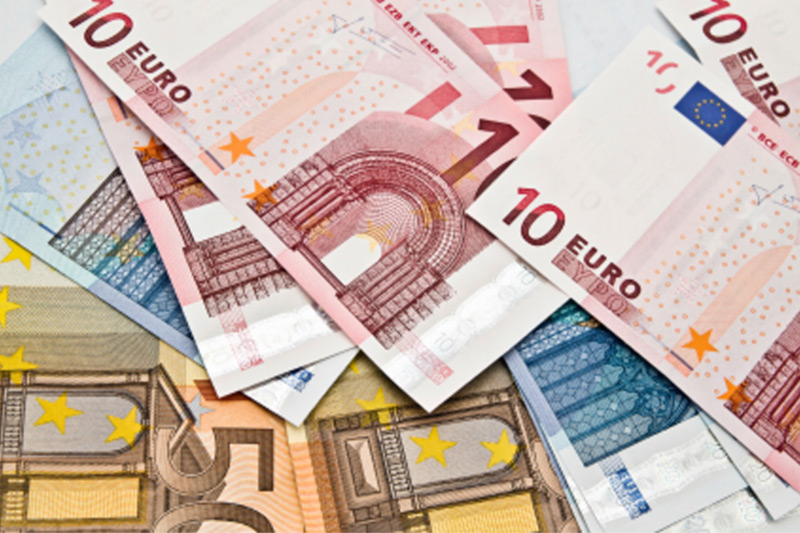Investing.com - The euro trimmed gains against the U.S. dollar and the yen on Thursday, as Italian borrowing costs continued to rise after an auction of government debt met with weak investor demand.
During European morning trade, the euro was higher against the U.S. dollar, with EUR/USD rising 0.16% to hit 1.3128, down from an earlier high of 1.3151.
Italy auctioned EUR2.88 billion of the EUR3 billion of three-year bonds on offer, at an average yield of 3.89% compared to 2.76% at a similar auction last month.
The euro found support after official data showed that industrial production in the euro zone rose unexpectedly in February, but the year-on-year fall was still the steepest since December 2009.
Eurostat said that industrial production rose to a seasonally adjusted 0.5%, from 0.2% in the preceding month, defying expectations for a 0.3% decline.
Industrial output dropped 1.8% in the year to February, in line with expectations.
Sentiment on the single currency also remained supported after a senior European Central Bank official said that the bank’s bond-buying program was still available as an option to ease pressure on peripheral euro zone bond yields.
The single currency was trading close to a three-month low against sterling, with EUR/GBP dipping 0.06% to hit 0.8236.
In the U.K., official data showed that the trade deficit widened more than expected in February as exports to countries outside the European Union dropped.
The Office for National Statistics said the goods trade deficit widened to GBP8.8 billion compared with a forecast of GBP7.7 billion and up from GBP7.9 billion in January.
The euro was higher against the yen, with EUR/JPY up 0.38% to hit 106.39, but came off an earlier high of 106.60.
Earlier in the day, the governor of the Bank of Japan said the bank will pursue “powerful easing” to help overcome deflation and put the economy on a sustainable growth path.
The euro was little changed against the Swiss franc, with EUR/CHF inching down 0.02% to hit 1.2023.
The shared currency was weaker against the Canadian, Australian and New Zealand dollars, with EUR/CAD losing 0.21% to hit 1.3130, EUR/AUD tumbling 0.72% to hit 1.2635 and EUR/NZD shedding 0.27% to hit 1.5980.
In Australia, official data showed that the economy added 44,000 jobs in March, far better than forecasts for an increase of 6,000, while the unemployment rate ticked down to 5.2%, from 5.3% in February.
Later Thursday, the U.S. was to release official data on initial jobless claims, as well as reports on producer price inflation and the trade balance.
During European morning trade, the euro was higher against the U.S. dollar, with EUR/USD rising 0.16% to hit 1.3128, down from an earlier high of 1.3151.
Italy auctioned EUR2.88 billion of the EUR3 billion of three-year bonds on offer, at an average yield of 3.89% compared to 2.76% at a similar auction last month.
The euro found support after official data showed that industrial production in the euro zone rose unexpectedly in February, but the year-on-year fall was still the steepest since December 2009.
Eurostat said that industrial production rose to a seasonally adjusted 0.5%, from 0.2% in the preceding month, defying expectations for a 0.3% decline.
Industrial output dropped 1.8% in the year to February, in line with expectations.
Sentiment on the single currency also remained supported after a senior European Central Bank official said that the bank’s bond-buying program was still available as an option to ease pressure on peripheral euro zone bond yields.
The single currency was trading close to a three-month low against sterling, with EUR/GBP dipping 0.06% to hit 0.8236.
In the U.K., official data showed that the trade deficit widened more than expected in February as exports to countries outside the European Union dropped.
The Office for National Statistics said the goods trade deficit widened to GBP8.8 billion compared with a forecast of GBP7.7 billion and up from GBP7.9 billion in January.
The euro was higher against the yen, with EUR/JPY up 0.38% to hit 106.39, but came off an earlier high of 106.60.
Earlier in the day, the governor of the Bank of Japan said the bank will pursue “powerful easing” to help overcome deflation and put the economy on a sustainable growth path.
The euro was little changed against the Swiss franc, with EUR/CHF inching down 0.02% to hit 1.2023.
The shared currency was weaker against the Canadian, Australian and New Zealand dollars, with EUR/CAD losing 0.21% to hit 1.3130, EUR/AUD tumbling 0.72% to hit 1.2635 and EUR/NZD shedding 0.27% to hit 1.5980.
In Australia, official data showed that the economy added 44,000 jobs in March, far better than forecasts for an increase of 6,000, while the unemployment rate ticked down to 5.2%, from 5.3% in February.
Later Thursday, the U.S. was to release official data on initial jobless claims, as well as reports on producer price inflation and the trade balance.
